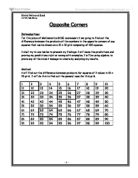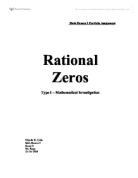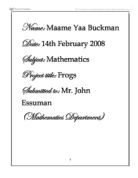(28 x 20) – (19 x 29)
= 560 – 551
= 9
By looking at the example 1 of the 9 x 9 grid I can see that the difference I get is 9, by considering the result of the 10 x 10 Grid I can say that the difference in 9 x 9 grid would be 9.
I predict that if I chose any of the square block in 9 x 9 grid I will get the difference of 9.
I will now do another example to prove or disprove my prediction
Example 2:
(67 x 59) – (58 x 68)
= 3953 – 3944
= 9
This example proved my prediction correct.
Now I will do the general case of 9 x 9 grid and will prove the general case algebraically that my answer comes is 9.
GENERAL CASE
(n + 9)(n + 1) – n(n + 10)
= (n2 + 10n + 9) – (n2 + 10n)
= 9
So looking back at the 10 x 10 grid and comparing it with 9 x 9 grid show us the pattern that the difference between the product depends on the grid e.g. if the grid is 10 x 10 then the difference would be 10 and if the grid is 9 x 9 then the difference would be 9, I predict that this is the case with all the other grids e.g. grid 4 x 4 would have the difference of 4.
I will now try to prove my prediction with the 4 x 4 grid and I will see if I was right or wrong.
(11 x 8) – (7 x 12)
= 88 – 84
= 4 I was correct.
Now I will try to prove the same thing algebraically as a general case.
GENERAL CASE
(n + 4)(n + 1) – n(n+5)
= (n2 + 5n + 4) – (n2 + 5n)
= 4
I will go back to the 10 x 10 grid and make different boxes and see what is the difference pattern
3 x 3 BOXES
Example 1:
(4 x 22) – (2 x 24)
= 88 – 48
= 40
This shows that the difference is 4, now I will do one another example and then I will find out the general case algebraically.
Example 2:
(76 x 58) – (56 x 78)
= 4408 – 4368
= 40
Now I will find the general case of this pattern and on the basis of my examples I predict that the difference would be 40.
GENERAL CASE:
(n + 20)(n + 2) – n(n + 22)
= (n2 + 22n + 40) – (n2 + 22n)
= 40
This shows that my prediction was right.
4 x 4 BOXES
Example 1:
(42 x 15) – (12 x 45)
= 630 – 540
= 90
Example 2:
(96 x 69) – (66 x 99)
= 6624 – 6534
= 90
GENERAL CASE:
(n + 30)(n + 3) – n(n+33)
= (n2 + 33n + 90) – (n2 + 33n)
= 90
RESULTS TABLE
Now I will try to find out the general formula for grids so I will be able to find out the difference of boxes for any type of boxes in 10 x 10 grid.
Now when I have noticed the pattern in my boxes I will try and find a general case so if I have any number of squared boxes then I will be able to find out the difference of opposite corners that by the formula.
n2 + 11nq – 11n – 20q + 10q2 +10 – n2 – 11nq + 11n
= 10q2 – 20q + 10
= 10 (q2 – q + 1)
= 10 (q – 1)2
Finally I have found the formula, which can be used for all the squares in 10 x 10 grid to find out the difference in opposite corners.
Now I will find out the formula of 9 x 9 grid.
2 x 2 in 9 x 9 grids
(23 x 15) – (24 x 14)
= 345 – 336
= 9
3 x 3 in 9 x 9 Grids
(37 x 21) – (39 x 19)
= 777 – 741
= 36
4 x 4 in 9 x 9 grids
(78 x 54) – (81 x 51)
= 4212 – 4131
= 81
5 x 5 in 9 x 9 grids
(64 x 32) – (68 x 28)
= 144
Results Table
Now I will start the investigation by drawing the rectangular grids on the 10 by 10 grids, I will now work out the general case and will try to find out the general formula which may work with all the other main grids e.g. 9 by 9 and 8 x 8 etc.
To begin with I shall first find the difference between the products of the numbers in the opposite corners of 2x3 rectangles.
Example 1:
34 x 26 - 24 x 36 = 20
Do all 2x3 rectangles have a difference of 20?
I will do another experiment to find the results to see if the result is 20 again.
Example 2:
58 x 50 - 48 x 60 = 20
It seems that the difference of product between 2 x 3 rectangles is 20. So by the help of results I achieved above I can predict that the product of the difference in opposite corners in 2 x 3 grids would be 20.
Therefore, I will do one more experiment to prove or disprove my prediction.
85 x 77 - 75 x 87 = 20
Finally I am able to prove my prediction correct, All 2x3 rectangles on the grid have a difference of 20.
However what if the rectangle is aligned differently on the grid, so the shorted sides are at the top and bottom? Will the difference for that still be 20?
46 x 65 - 45 x 66 = 20
Therefore, I can say that the difference is 20 no matter which we around we make the rectangle of 2 x 3.
I will now try rectangles with the same height of two, but different lengths.
20
2 x 4:
22 x 15 - 12 x 25 = 30
2 x 5:
56 x 50 – 46 x 60 = 40
It seems to me that whenever I increase the width by one, the difference increases by ten.
So considering the above 2 results. I predict that the difference for a 2 x 6 rectangle will be 50.
2 x 6:
81 x 76 – 71 x 86 = 50
So my prediction was correct
In order to compare and find out the general formula I will now put all of my results in the table below:
The area increases by 2 each time. This is because the length is always being multiplied by the height of 2.
The difference increases by 10 each time, also each line of the grid is 10 squares wide so the next square vertically straight down is ten more than the square above it.







